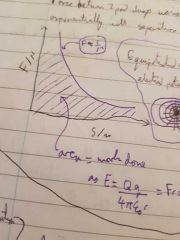![]()
![]()
![]()
Use LEFT and RIGHT arrow keys to navigate between flashcards;
Use UP and DOWN arrow keys to flip the card;
H to show hint;
A reads text to speech;
27 Cards in this Set
- Front
- Back
|
Test for electric fields |
Thin good strip attached to insulator charged positively by touching a charged object, therefore electrostatically repel and moves away |
|
|
Electric field strength |
Force experience per unit positive charge |
|
|
Static electricity |
Rub cloth on balloon Electrons transfer making balloon negative Negative balloon touches wall repelling wall's electrons Wall is now positive so attracts balloon so balloon sticks to wall |
|
|
Coulomb's law |
According to newtons 3rd, 2 point charges exert opposite charges on eachother F prop Qq F prop 1/r^2 Therefore F = k Qq/r^2 Therefore F = Qq/4 pi £0 r^2 |
|
|
Investigating coulomb's law |
Balance and insulating rulers between 2 charged balls of equal charge and positive weight change due to newtons 3rd law |
|
|
2 factors capacitance depends on and equation |
Area of plates and separation C prop A/d |
|
|
Electric potential |
Work done per unit charge in bringing that charge from infinity to that point |
|
|
Equipotential |
Line in which electric potentials are the same |
|
|
How force varies with separation of 2 point charges |

|
|
|
Magnetic field |
Field surrounding a permanent magnet or current |
|
|
Electromagnetic |
A current carrying wire has a magnetic field created around it |
|
|
To determine flux density |
Set up 2 magnets on scales With current they experience a force upwards Due to newtons 3rd law there is an opposite force read on scales F=BIL |
|
|
Why electron moves circularly in a magnetic field |
Electrons enter field and experience downwards force
This changes their direction continuously
Fleming's rule shows force experienced must always be at 90 to current
Therefore force is centripetal
Therefore mv^2/r = mv/BQ |
|
|
How are factors prop to radius of motion |
R prop v R prop m R prop 1/B R prop 1/Q |
|
|
Velocity selector |
Device using electric and magnetic fields to select charged particles of a certain velocity and deflect only them from the 2 parallel plates |
|
|
Electromagnetic induction |
Work done in moving magnet Magnets motion at 90 to flux make electrons move Their movement is a current which provides electrical energy for the work Energy is conserved |
|
|
Flux |
O, Wb, product of flux density at 90 to an area and that area itself |
|
|
Flux density |
B, T, strength of flux as force per unit product of current and length |
|
|
Flux linkage |
NO, Wb turns, product of flux and no. turns |
|
|
When is emf induced |
Magnet moves at 90 to flux which causes a change in flux. Change in flux, current, or angle induce emf |
|
|
Faraday's law |
Magnutude of induced emf prop rate of change of flux linkage |
|
|
Lenz's law |
Direction of induced emf or current opposes direction of change producing it |
|

|
In order for work to be done in moving away, the magnets motion must be opposed Wires of coil induce own flux and emf In order to conserve energy, direction of electrical energy must oppose that of kinetic energy |
|
|
How lenz's law regulates motor speed |
Motion caused by current is in opposite direction, so current slows it down |
|
|
Magnet falling down copper tubing |
Flux lines if the tube are being cut
This induces a current causing an emf which creates it's own flux
This own flux opposes motion slowing it down therefore Lenz's law |
|
|
Transformers |
Vp alt has ip alt Ip creates alt flux Iron core links this to 2ndary coil 2ndary coil gains alt flux inducing alt emf inducing alt current Rate of change of flux linkage prop emf |
|
|
Transformers power losses and solutions |
Coils by heating- thicker wires so less resistance Core- lamination Internal hysteresis- alloys that conduct flux but are electrically insulating to eddy currents Flux failing to link |

